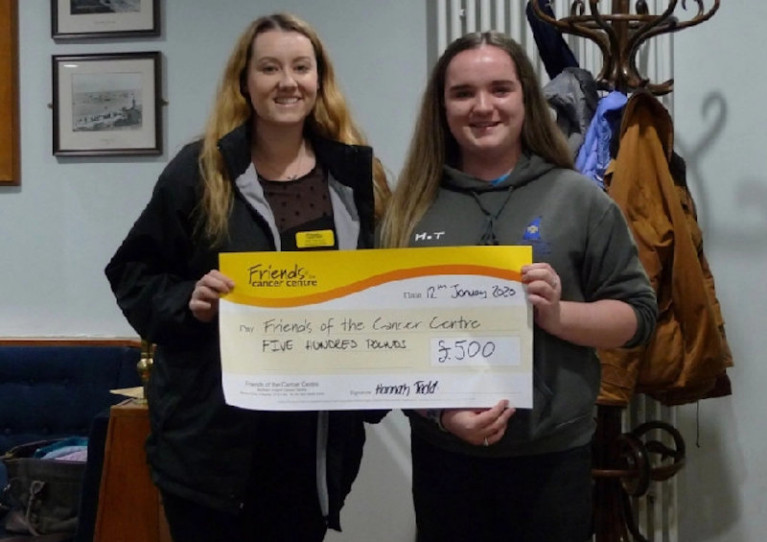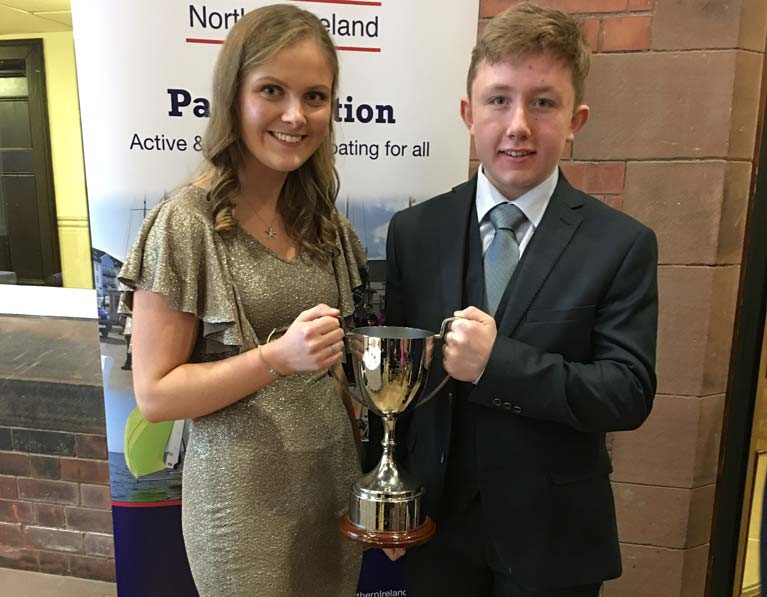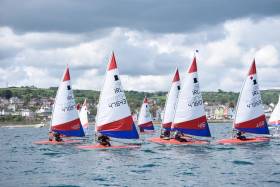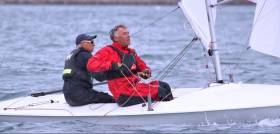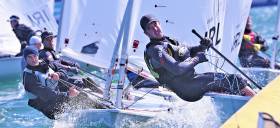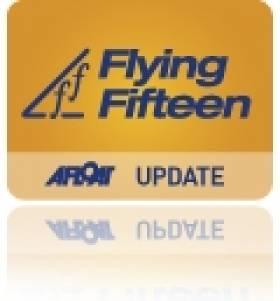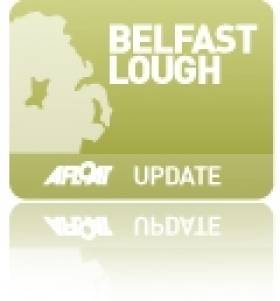Displaying items by tag: County Antrim Yacht Club
Whitehead's County Antrim Yacht Club is Only Northern Ireland Club in Running for RYA Club of the Year Award
Northern Ireland's County Antrim Yacht Club has been selected as a finalist for the second year running in the UK-wide RYA Club of the Year Awards.
The Club lies on the northern shore of Belfast Lough in the town of Whitehead and enjoys a very expansive sailing and racing area.
Peter Darragh, Commodore, says CAYC has been shortlisted with 11 other clubs from across the UK, selected from over 1500 RYA-affiliated clubs, and Darragh says he “is proud to be the only NI club in the running".
For this year’s awards, the four categories are:
- Community Club of the Year
- Green Club of the Year
- Active Club of the Year
- Young Person's Club of the Year
The overall 2024 Club of the Year will be selected from the winners of these categories and County Antrim YC is in the Active Club section up against Clyde Cruising Club, Colne Yacht Club and Derwent Reservoir Sailing Club.
The Commodore continued, “This is a great recognition of the phenomenal effort and dedication of our volunteers in promoting sailing, boating and safe use of the water. We work hard to introduce people to the sport and support them to achieve their goals, all the while engaging proactively with our local community and supporting the wider regional sailing fraternity. Keeping the Club active and having something to offer all members is a constant challenge, but one which we continue to do our best to rise to. We're proud to be selected as a finalist and grateful to have such a committed membership base."
Last year, among the many young club members’ successes, were Luke Simpson’s sixth in the Topper Worlds, 3rd overall in the Irish Topper Nationals, a win in the Topper 5.3 Irish Topper Series and 3rd at British Nationals.
Hon Sailing Secretary Sheela Lewis offered her congratulations to the CAYC competitors in the RYANI Youth Championships at Ballyholme YC. “ To the winners and all those competing representing their Clubs and Schools”. She reports also that having transitioned to the ILCA 4 class, Luke finished second in the RYouth Championships.
 County Antrim Yacht Club's Luke Simpson racing in the Irish Topper Nationals Photo: Simon McIlwaine
County Antrim Yacht Club's Luke Simpson racing in the Irish Topper Nationals Photo: Simon McIlwaine
Also notable was Calum Pollard’s shortlisting for the RYA NI in the 2022 Young Sailor of the Year category, having claimed Gold at the Topper 4.2 Worlds. He was also awarded Junior Sportsperson of the Year, celebrating his 2022 successes, at the Mid and East Antrim Council Sports Awards.
 CAYC's Calum Pollard was a gold medal winner at the Topper Worlds Lake Garda in 2022
CAYC's Calum Pollard was a gold medal winner at the Topper Worlds Lake Garda in 2022
Jenna Reid who races a 49erFX and with clubmate Ellen Barbour (also East Antrim BC) are part of the Irish 49erFX team competing on the International circuit and campaigning for a place in the 2028 Olympics. Also in the two-handed dinghy RS400 class, Joycelyn Hill and Rowan Berry represented CAYC at the RS400 winter series and finished fifth overall.
The awards ceremony is at the RYA Dinghy and Watersports Show on 24 February.
122-Year-Old Waverley Yacht Class Connects Two Northern Ireland Finalists in the RYA Club of the Year Awards
Northern Ireland's Ballyholme Yacht Club and County Antrim Yacht Club have both been announced as finalists in the RYA Club of the Year 2023.
Although six miles apart on opposite sides of Belfast Lough, the clubs were formed within about twenty years of each other, CAYC emerging with the twentieth century in 1902 and Ballyholme in 1919. But one keelboat class connects the two, the Waverley class, designed by John Wylie and first raced in 1903 at Whitehead, the home of County Antrim YC. By the end of WW1, the class was no longer exclusive to CAYC, and two boats were built at Ballyholme. By 1961 when the class had been reformed as a racing class at BYC, there were Waverleys at most Belfast Lough Clubs. Now the class has moved on again, this time to Strangford Lough Yacht Club at Whiterock.
As Afloat reported earlier, both clubs are passionate about youth sailing.
Ballyholme Yacht Club
In 2018 the Ballyholme club had one Topper racing regularly, and at a recent Topper event, 35 of the competitors were BYC cadets. The club is known both locally and internationally as expert at hosting big events and in the past those have included not only its local regatta but the ISA Youth Championships, ILA Masters, RS 400/200/Feva Nationals, the RYANI Youth Championships and Optimist Ulsters. Many of the youth sailors are in the RYANI Topper and ILCA squads, and among its members are past Olympians such as Bill O’Hara and Matt McGovern. Also, John Driscoll, Chris Boyd, and Conrad Simpson have all represented Ballyholme at Olympic Games in the Finn class, and the club hosted the Finn Gold Cup (World Championship) in 1992. Other club activities are open-water swimming and Stand Up Paddleboarding.
 RS Feva racing at Ballyholme Yacht Club Photo:Simon McIlwaine
RS Feva racing at Ballyholme Yacht Club Photo:Simon McIlwaine
Commodore Dougie Rennie commented, “It is, of course, a privilege to be nominated again for this award and is a testament to the members of BYC who volunteer to help BYC host all the events and activities that the club puts on for the benefit of all sailors and the wider community”.
County Antrim Yacht Club
County Antrim YC is a relatively small club delivering a varied and successful programme of activities on the water and ashore, planned to benefit club members and the local community, including charities. The club has a strong volunteering culture and encourages members from all backgrounds to access the water, free-of-charge or low-cost dinghy loans and courses are offered. The club’s junior development pathway resulted in 2022 successes at regional and national, and world championship levels. In addition, the club hosts regional and national events, most recently the Flying 15 Northerns. The club provides race management and mark laying/safety boat teams to support events across Northern Ireland, including Irish Sailability and the RYANI Youth Championships. CAYC introduced ‘try sailing’ days and a ‘get to know your club’ day, with targeted communications resulting in significantly increased membership.
 Flying Fifteen keelboat racing at County Antrim Yacht Club Photo: CYCA
Flying Fifteen keelboat racing at County Antrim Yacht Club Photo: CYCA
The club believes it can have a cohesive role in its relatively small community and has worked with local stakeholders to host community events coming out of the pandemic. It has bulk-purchased SUPs and kayaks so there are now around 30 and 40, respectively available, enabling non-sailing members to get on the water and reach out to non-members. Due to 2022’s new-member successes, the club is providing additional training and coaching efforts – it also identified a Covid-related age gap in junior sailors and is planning additional confidence-building coaching sessions for the 2023 pre-season.
Commodore Peter Darragh is delighted that his club will be one of 12 clubs shortlisted for RYA Club of the Year. “This is significant given over 1,000 other diverse clubs across the UK are in the running for this accolade. A successful club is built on its members, so we see this as a great recognition of the hard work, expertise, and commitment our volunteers put into operating a very full calendar of sailing and other water-based activities. Support for our members ranges from structured training for those new to sailing to coaching and assisting those experiencing racing success on a world stage. We also play an important role in supporting the wider sailing fraternity in Northern Ireland and love being at the heart of our local community: encouraging young and old to give sailing a go and be safe on the water. We’re a small club with a big impact and are very proud to have this validation of our efforts.”
Young Co Antrim Sailors Give Back To Their Community
Young sailors from County Antrim Yacht Club have been making a positive difference to their community by fundraising £1,500 in just under two years.
Junior captains Amy Armstrong and James Corbett, alongside vice captains Hannah Todd and Michael Rock, led the club’s juniors to co-ordinate a series of successful and innovative fundraising activities.
The Junior Committee, under the guidance and leadership of Gavin and Claire Pollard, have been fundraising since they joined together in 2018.
Their success was celebrated when Amy and James, who represented the Junior Committee, were crowned Young Volunteers of the Year at this year’s RYANI Annual Awards.
To date, they have donated £500 to the Friends of the Cancer Centre and are the main sponsors of County Antrim Yacht Club’s (CAYC) Spring Series 2020 after they donated £250 to Commodore Paul Abraham.
Gavin Pollard, club coach and former captain at CAYC, said: “The juniors have been hugely influential in co-ordinating all their own fundraising activities, in-house and within the community, with truly ingenious and powerful ideas.”
Their successful fundraising efforts included making Christmas presents, which were bought and posted as far as Spain.
In March 2019 they arranged the All-Ireland premier of Maiden — the film of Tracy Edwards and crew’s Whitbread Round the World Race — which was screened in the club and attracted VIP guest Professor Louise Dubras, who was hugely influential in the original Maiden project.
“The juniors have been very creative in their approach to fundraising and at CAYC we are all very proud of what they achieved,” Pollard said.
“With their sponsorship of the Spring Series this year they will have ownership of the event but they will also get a great sense of achievement by contributing and giving back to the club in a way which they never thought they could.”
Fundraisers at County Antrim Yacht Club won the Young Volunteer of the Year at the RYA Northern Ireland Awards last night in the Queen’s University’s Riddel Hall writes Betty Armstrong.
The century-old CAYC, which lies on the north shore of Belfast Lough, has a Junior Committee to be envied. Since the group’s formation in 2018 it has raised, on behalf of the junior members, £1500.
The committee has reached this total by cleverly coordinating their fund-raising activities, both in-house and within the community, with truly ingenious and powerful ideas. Some of these ideas included creating Christmas presents with a full Production Line, Marketing Team and Sales Department. Some were even bought and posted to Spain! In March of last year, they arranged, through the power of parental contacts, the All Ireland premier of “Maiden” which was screened in the club. Thirty years ago Tracy Edwards’ Maiden, became the first all-female team to sail around the world and into the record books. The Juniors, under the careful lead of CAYC Junior Committee, took control of all ticket sales, marketing and refreshments for the evening. They arranged a VIP Guest for the evening, Professor Louise Dubras, Foundation Dean of the School of Medicine at Ulster University’s Magee Campus in Derry. She was hugely influential in the original Maiden project onboard, her husband also leading the Team Rebuild on both occasions! The evening was a huge success. These are just some examples of their ingenuity.
Of the £1500 raised the Juniors donated last weekend, £500 to a charity which is close to their hearts along with all of the CAYC family, the Friends of the Cancer Centre. This has been largely driven by Junior Vice Captain Hannah Todd who has close links with the charity.
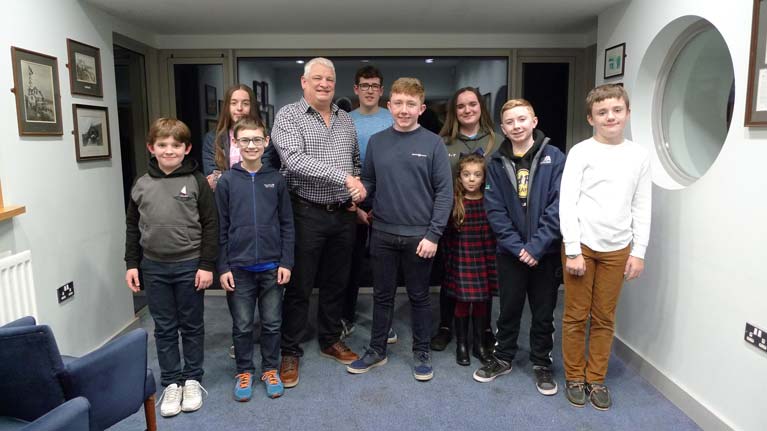 CAYC Junior Captain James Corbett agreeing on the sponsorship deal of CAYC Spring Series 2020, on behalf of all CAYC Juniors, with Commodore Paul Abraham
CAYC Junior Captain James Corbett agreeing on the sponsorship deal of CAYC Spring Series 2020, on behalf of all CAYC Juniors, with Commodore Paul Abraham
And after talks with the General Committee, the CAYC Juniors are now main sponsors of this season’s Spring Series after Commodore Paul Abraham accepted their offer of £250. In doing so this not only encourages them to take part in this series by having ownership of it but also gives them a sense of achievement by contributing in a way which they never thought they could.
All of this would not be possible without the enthusiasm of all the Juniors at the club and the co-ordination led by the Junior Captains Amy Armstrong and James Corbett along with the Junior Vice Captains Hannah Todd and Michael Rock.
And a bonus arising from the Junior’s efforts is that the formation of the Junior committee has helped convert the less active into increased participation in club matters as they have become the decision makers.
“And as this has happened in the off-season” Club Race Coach and Committee member Gavin Pollard says “it is more than likely helping increase interest in clubhouse events which they have arranged themselves”.
1 Junior Vice Captain Hannah Todd, presenting Amy from Friend’s of the Cancer Centre with a cheque of £500.
2 CAYC Junior Captain James Corbett agreeing the sponsorship deal of CAYC Spring Series 2020, on behalf of all CAYC Juniors, with Commodore Paul Abraham.
Report From Topper Traveller 3 At County Antrim Yacht Club
County Antrim Yacht Club in Whitehead hosted the ITCA (IRL) Topper Traveller 3 on Sunday 9 June, kindly sponsored by Ryobi.
A total of 53 Toppers entered the event, with representation from 20 yacht clubs across Ireland. Many competitors enjoyed a day of race training on Saturday to practice for the event.
Race officer Sheela Lewis performed well under variable conditions and all four scheduled races were completed.
Competitors faced lighter winds which built to a stormy final race, with safety teams working hard to ensure all sailors returned safely to shore.
In the 5.3 fleet, Adam Irvin from the National Yacht Club took top honours with only 5 points. Closely following were Darragh Collins from the Royal Cork Yacht Club and Ethan McCormac from Cushendall Sailing and Boating Club in second and third place respectively.
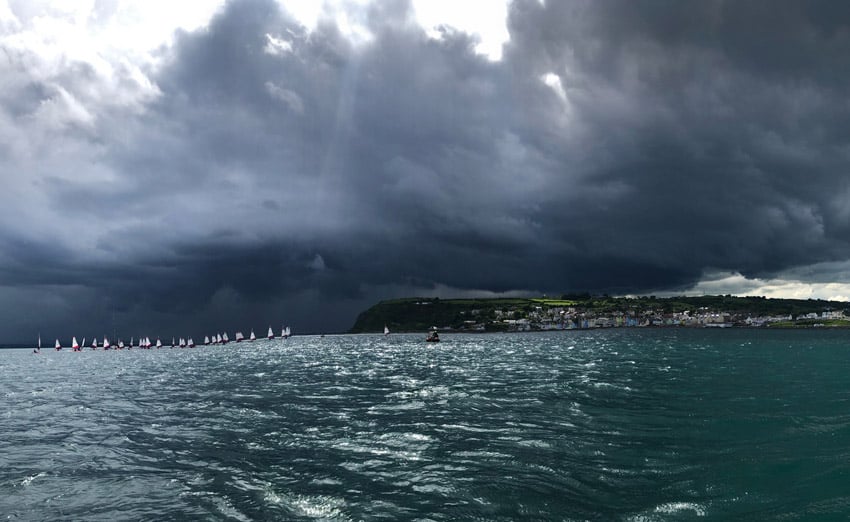 Dramatic skies as the Toppers return to shore | Photo: Laura Robinson
Dramatic skies as the Toppers return to shore | Photo: Laura Robinson
Ryan Collins of the Royal Cork had an impressive win in the 4.2 fleet with 3 firsts. Daniel Palmer of Donaghadee Sailing Club took second place followed by Ella Fitzgerald from Clontarf Yacht & Boat Club/NYC.
The Regatta fleet saw novice sailors perform well, hopefully whetting their appetite for more racing this summer. Callum Jackson and Patrick Rainey, both from Coleraine Yacht Club, took first and second place respectively, followed by Georgia Rafferty representing the home club.
Rear Commodore Francis Rock organised a team of over 60 volunteers from the club to ensure the visitors had a warm welcome and well supported sailing from launching through to recovery.
The host club expressed its thanks to Ryobi whose sponsorship made the event possible, to Laura Robinson who provided photography for the event, to ITCA (Ireland) and to Francis, Sheela and the full volunteer team.
World Flying Fifteen Champion Cruises to Victory at County Antrim Yacht Club
Perennial Steve Goacher from Lake Windermere sailed to victory in a single race on the final day of the Flying Fifteen Irish Championships at County Antrim Yacht Club. The multiple World and British Champion, sailing with Dun Laoghaire's Alan Green, counted five race wins in the six race series.
Today's single windward leeward race was raced on an inshore course given the gusty conditions at Whitehead.
Strangford Lough boats took second and third places. Andrew McCleary and Colin Dougan from Killyleagh finished second Andy and Rory Martin in third.
Waterford Harbour's Lee Statham and Andrew Paul took fifth and were the first boat from the Republic.
There will be some disappointment that the first Flying fifteen from the fleet stronghold at Dun Laoghaire was as far back as tenth in the 24–boat national championship fleet.
Download overall results below.
The Irish Olympic Laser trials looked like they were being sailed on home waters a week ago when the two protagonists for the single mens Laser berth in Rio this summer contested the Ulster Championships at County Antrim Yacht Club at Whitehead. Significantly, perhaps, in advance of the final trial later this month, it was the young Leinster helmsman who was celebrrating his birthday that weekend had the edge over trials leader James Espey from Belfast.
A combined fleet of nearly 100 boats in 4.7, radial and full rigs witnessed the Olympic class dog fight in a windy and cold championships. 'It was superb to see Lynch, Espey plus O’Sullivan on the local circuit', said one seasoned Laser campaigner.
Lynch's NYC team-mates enjoyed the Antrim challenge too and posted results at or close to the top of all of the fleets. Heather Spain topped the Laser 4.7 fleet winning both first place overall and the girl’s first spot. Also achieving podium places were Hugh Perrette second place in the Laser 4.7 fleet, Evie Byrne, second girl and Clare Gorman third girl in only her second Laser event. Jenny Fekkes was third girl in the Laser Radial fleet.
Full results downloadable below.
#flyingfifteen – Frequent visitor to Ireland, UK Flying fifteen champion Charles Apthorp, sailing with Alan Green, produced four wins at the East Coast Championships to be unstoppable at a windy County Antrim Yacht Club at Whitehead yesterday. The National Yacht Club's David Gorman and Chris Doorly were second (on tie– break) in the 20–boat fleet with County Antrim's own Bryan Willis and John McPeake third. Full results downloadable below.
On Saturday three races were held in 10-25 knots of breeze from the west/sw. Being so close to the land it was shifty towards the shore and the wind coming around the headland also had an impact on conditions. Racing started at 2pm,
Race 1: the tide was going out towards the north and this held boats back on the line, the pin was favoured and with the wind out on the left it was important to get a good start. Gorman got a great start and soon tacked across the fleet, he led at the weather mark with Apthorp hot on his heels, Apthorp took the lead on the run and held it to the end, on the second beat Gormans outhaul broke and he was out of the race, not good to use your discard so early but he was up and running for the next race. Mc Cleery was second with Malcolm Crichton & Barry Bridges (SSC) third.
Race 2: The wind and rain were lashing the fleet at this stage. Apthorp won comfortably with Gorman chasing him all the way to be a comfortable second. There was confusion as to how many laps were sailed, after three there was no blue flag up so the fleet sailed another but it didn't affect positions. Chamberlain broke his jib halyard and at the weather mark there was a pile up involving three boats with the end result a large hole in Marcus Crichtons boat- no more sailing for him and his crew Roy.
Race 3: the boat end was favoured, Apthorp got away as Gorman got held up at the start by boats sailing over and not going up to keep clear as they should at the start, despite this he was up in third place at the weather mark behind Apthorp and McCleery. On the next beat the two leaders sailed to the left as Willis, Gorman and Mathews headed in towards the shore, this paid and the three were really close all the way to the finish line, the downwind leg was particularly exciting with boats vying for inside position at the last leeward mark. Local man Brian Willis & John McPeak deservedly won with Mathews second , Gorman third with Apthorp and McCleery back quiet a bit in fourth and fifth place.
On reaching the shore after the three races the well organised helpers on the slip were a welcome sight as were the soup and bread rolls. There was an excellent meal provided later in the club and the revelry in this fine club went on late into the night.
For Sunday the forecast was for the strong winds to continue but on arrival it was moderate, there was an early start so we could get in before the low tide.
In Race 4: Gorman got squeezed out at the start and had to turn round and start in the second lane at the committee boat, he headed in towards the shore but left paid and Apthorp led all the way with McKee, Chamberlain and Crichton all chasing. The wind was up now particularly further out of the shelter of the land and there was some great downwind sailing. On the last beat Gorman worked hard on the shifts and just managed to pip Chamberlain and Crichton on the line. The win was enough for Apthorp & Green to retain the title they won last season.
Race 5 was a triangle Olympic course with some hard reaches thrown in just to tire the already tired crews. Gorman lead at the weather mark but was overtaken on the reach by the heavier crew on Frequent Flyer. After some great reaches and close racing Apthorp and Gorman got well ahead of the pack on the second beat to finish in first and second place in the race and overall. Chamberlain was third with Irish Champion McCleery & Dougan fourth in Race 5. Small consolation for Gorman & Doorly is that they are back on top of the Irish Ranking table.
At the prize giving local class captain and Commodore thanked the sponsors and the many volenteers including the PRO and his team. On behalf of the winning crew Alan Green also thanked all involved in the club and also his fellow competitors who all made the effort to travel to this great part of the Irish coastline.
The next event is the Northern Championships which will be held in Whiterock Stangford Lough in June.
#420 – Howth Yacht Club's Robert Dickson and Sean Waddilove continue their unbeaten run in the 420 dinghy class but they did not get it all their own way in the early stages of the Ulster Championships at County Antrim Yacht Club at the weekend.
Royal Cork's Peter McCann and Arran Walsh took the first three races in the ten boat fleet before the youth national champions got into their stride at Whitehead.
Full results available to download below as a jpeg file.
RYA Volunteer Awards for Belfast Lough Sailors
#RYAAwards - Two sailors from Northern Ireland have received awards from the Royal Yachting Association for their voluntary work, as the Carrickfergus Times reports.
Belfast Lough locals Sheela Lewis from Whitehead received Karl Blythe from Carrickfergus were among 56 people commended by Britain's Princess Royal at the RYA Volunteer Awards in London recently.
Lewis, the first female commodore of the County Antrim Yacht Club, was presented with the Lifetime Commitment Award for her hard work in developing the small club's sailing courses.
And Blythe was nominated by Belfast Lough Sailability for the Youth Award for his dedication to helping others get into sailing and promoting the club online, even while facing the challenges of his autism spectrum disorder.
“I really enjoy helping out with Belfast Lough Sailability and don’t think I do anything more special than any other volunteer," said the 19-year-old. "I really enjoy getting involved, not only with the sailing and on-the-water activities but also helping behind the scenes."


























